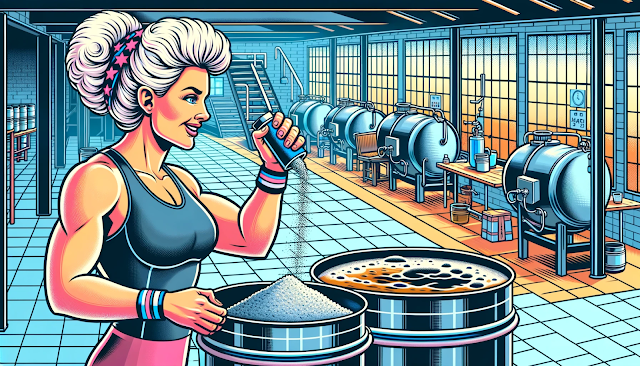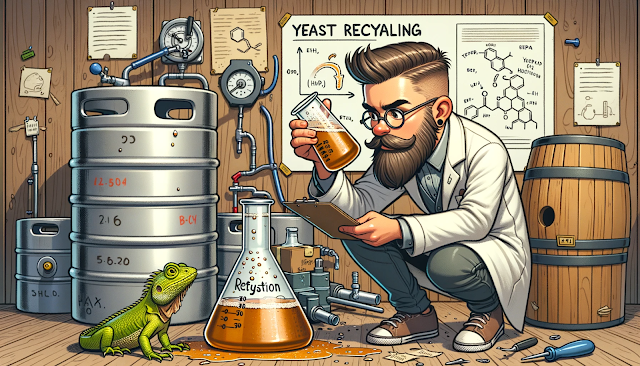This epochal discovery was not an isolated event but a part of the broader scientific awakening of the 19th century. It was during this period that Louis Pasteur furthered de la Tour's work, linking yeast to the process of fermentation definitively and explaining how it could be harnessed and controlled.
Yeast: The Microbial Alchemist in Brewing
Turning to the microorganism itself, yeast's role can be likened to that of an alchemist, capable of transforming base materials into substances of value. Biologically, yeast belongs to the kingdom of fungi and is a single-celled organism. There are numerous species and strains of yeast, each with unique properties and effects on the brewing process. In the realm of beer brewing, the Saccharomyces Cerevisiae family reigns supreme, specifically its two distinguished members: ale yeast and lager yeast.Ale yeasts are top-fermenting, meaning they tend to rise to the surface of the brew during fermentation, while lager yeasts are bottom-fermenting and settle at the bottom. This differentiation is not merely a matter of visual interest but has practical implications for the brewing process, influencing factors like fermentation temperature, the speed of fermentation, and the flavor profile of the beer.
Yeast Behavior and the Art of Brewing
The introduction of yeast to the brewing mixture marks the beginning of the fermentation process, the transformative period when sugars are converted into alcohol and carbon dioxide. This biochemistry is at the heart of brewing, but it's not a "set it and forget it" affair. Successful fermentation demands meticulous attention to various parameters, including temperature, pH levels, and the presence of nutrients.
Brewers must cultivate an almost symbiotic relationship with their yeast, providing it with the ideal conditions to thrive while also steering its activity toward the desired outcome. This interplay is where the art and science of brewing converge. The brewer must understand the biological needs and behaviors of yeast and apply that knowledge with precision and care.
A deep dive into the world of brewing yeast reveals a landscape rich with diversity and complexity. Each strain has its personality, so to speak, with specific tolerances for alcohol and temperature, and each imparts different flavor profiles to the beer. Master brewers learn to navigate this terrain with a blend of empirical knowledge and creative intuition, selecting and nurturing yeast strains to achieve a harmonious balance of flavors.
The Unseen Craft: Precision and Care in Yeast Integration
Incorporating yeast into beer is akin to adding the soul to the body. It's a delicate process that requires more than just technical knowledge; it requires a nuanced understanding of the living organism that is yeast. The brewer must ensure the yeast is healthy and vigorous before introducing it to the wort—the sweet liquid extracted from malted grains. They must also constantly monitor the fermentation process, adjusting conditions as needed to maintain the yeast's health and activity.The craft of brewing with yeast is, therefore, an ongoing dialogue between brewer and microbe, a collaboration that underpins the creation of every beer. It's a journey that begins with the selection of a yeast strain and continues through the careful orchestration of the fermentation environment, all to achieve a beer that is more than just the sum of its parts, but a drink that tells a story—a story of science, history, and the transcendent power of yeast.
Distinctive Fermentation Traits of Ale and Lager Yeast
The divergence in fermentation characteristics between ale and lager yeasts is one of the most pivotal aspects that dictate the very identity of beers within these two categories. The behaviors of these yeasts during fermentation are not simply a matter of preference but are rooted in centuries of brewing tradition and biological specialization.
Ale Yeasts: The Warm, Ester-Forward Fermenters
Ale yeasts, known scientifically as Saccharomyces cerevisiae, are robust organisms that perform best in moderate to warm conditions, typically between 10-25°C (50-77°F). At these temperatures, ale yeasts exhibit vigorous fermentation activity, often creating a thick, frothy layer of krausen at the top of the fermenter. This "top-fermenting" trait is not only a matter of spatial orientation but also influences the interaction between the yeast and the fermenting wort.
The warmer fermentation environment promotes the production of esters—volatile flavor compounds that can impart a range of fruity and floral notes to the beer. These esters are often desirable in ale styles, adding complexity and depth to the flavor profile. However, this same environment can also lead to higher alcohol production and lower attenuation, meaning that the yeast may not fully consume all available sugars, resulting in a beer with a sweeter, fuller body.
Lager Yeasts: The Cool, Clean Fermenters
In contrast, lager yeasts, classified as Saccharomyces pastorianus, are "bottom fermenters." They gather at the bottom of the fermenter and are more suited to cooler temperatures, thriving at 7-15°C (45-59°F). This preference for cooler conditions slows down the yeast's metabolism, which results in a longer fermentation period. The reduced metabolic rate also means fewer esters and other byproducts are produced, leading to the characteristically clean and crisp profile of lager beers.
Lagers often have a more subtle flavor profile, with a focus on the malt and hops rather than the yeast-derived flavors. The lower temperatures also contribute to a higher attenuation level, where yeast consumes a greater percentage of the sugars, typically resulting in a drier finish and a more pronounced bitterness when hops are present.
Yeast Pitching: The Critical Intersection of Timing and Temperature
Pitching yeast is a term used to describe the process of adding yeast to the cooled wort. This step is crucial, as the environment into which the yeast is introduced can have profound effects on its health and fermentation efficiency. The process is delicate; the wort must be cooled to a temperature that is hospitable for the yeast but not so cold as to shock or so hot as to kill it.For ale yeasts, the pitching temperature is usually around room temperature, while for lager yeasts, the temperature should be closer to the lower end of their preferred range. The objective is to provide an environment where the yeast can acclimate and begin to reproduce before starting the bulk of the fermentation.
The volume of the wort is often adjusted to a standard size, such as 23 liters, to standardize the process. Brewers add cold water not only to reach this volume but also to help achieve the target temperature. This process, known as "topping off," is common in homebrewing and smaller craft brewing operations where precise temperature control can be a challenge.
Once the yeast is pitched, the brewer's role shifts to careful monitoring. They must keep a vigilant eye on temperature fluctuations, which can cause the yeast to become stressed, leading to off-flavors or a stuck fermentation where the yeast ceases to convert sugars into alcohol and carbon dioxide.
The art of brewing, therefore, hinges on a deep understanding of yeast and the delicate balance of conditions required to coax out its best performance. The choice between ale and lager yeast is not merely one of flavor preference but a decision that affects every aspect of the brewing process, from fermentation kinetics to the final taste profile of the beer.
The Critical Role of Yeast Vitality in Beer Brewing
Yeast vitality can be considered as one of the pivotal gears in the clockwork of beer brewing. The age and health of yeast cells are crucial to their performance during fermentation. As yeast ages, its ability to reproduce and metabolize sugars effectively diminishes, which can lead to a range of issues from slow fermentation starts to incomplete fermentations.Freshness of Yeast: Ensuring Peak Performance
In the pursuit of brewing excellence, the freshness of yeast is as paramount as the quality of the malt and hops. Fresh yeast comes teeming with healthy, vigorous cells ready to tackle the sugars in the wort. Old or underperforming yeast, often referred to as "tired," can lead to a slew of problems. For instance, tired yeast may require higher pitching rates, which translates to using more packets or vials of yeast to achieve the desired cell count. This not only affects the brewing economics by increasing the cost but may also influence the final flavor profile of the beer.
The Utility of Yeast Starters in Brewing
To combat the pitfalls of using tired yeast, brewers can employ a yeast starter. This is essentially a mini batch of beer that is used to awaken and multiply yeast cells. By feeding the yeast a simple wort, usually made from dry malt extract and water, the brewer can revitalize the culture, increasing the cell count to ensure a vigorous fermentation. This is particularly crucial when brewing high-gravity beers, which require more yeast due to the higher sugar content, or when the viability of a liquid yeast culture is questionable.
A well-made yeast starter not only boosts cell count but also helps in assessing the yeast's health before it is introduced to the full volume of wort. A vigorous starter is a good indication that the yeast is capable of performing the task ahead.
Baking Yeast Versus Brewing Yeast: A Functional Distinction
While both baking and brewing yeast are of the same species, Saccharomyces cerevisiae, their selection and cultivation over the years have specialized them for their respective roles. Baking yeast has been optimized for rapid CO2 production to lift and aerate bread dough. Its alcohol tolerance is typically lower than that of brewing yeast, which is selectively bred to withstand the alcohol environment of beer and contribute to its flavor profile.

While in a pinch, baking yeast can ferment beer, it is not designed for it. Brewers may find that beers fermented with baking yeast have unexpected flavors and often lack the alcohol content or clarity achieved with brewing yeast. Furthermore, the flocculation properties—that is, the ability of the yeast to clump together and settle out of the beer—differ significantly between baking and brewing yeast, often leading to cloudier beer when baking yeast is used.
The Takeaway: Yeast Viability and Preparation
The takeaway for brewers, both novice and experienced, is that yeast management is as integral to brewing as any other aspect. Understanding the importance of yeast vitality, the advantages of using a yeast starter, and the differences between yeast strains can mean the difference between a good beer and a great one. Yeast, although a microorganism, has macro effects on the brewing process, and its impact on beer cannot be overstated. Whether it's ensuring the use of fresh, high-quality brewing yeast or preparing a nutrient-rich starter, these steps are essential to the craft of brewing, setting the stage for the magical transformation of wort into beer.
Conclusion
Understanding and working with yeast is fundamental to brewing beer. From the selection of the appropriate strain to the careful handling and pitching of yeast, each step plays a crucial role in the brewing process. By mastering these elements, brewers can create beers with the desired flavors, alcohol content, and clarity, paying homage to the centuries-old tradition that Baron Charles Cagniard de la Tour helped shape.











